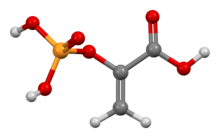Phosphoenolpyruvic acid

| |

| |
| Names | |
|---|---|
| Preferred IUPAC name
2-(Phosphonooxy)prop-2-enoic acid | |
| Other names
Phosphoenolpyruvic acid, PEP
| |
| Identifiers | |
3D model (
JSmol ) |
|
| ChEBI | |
| ChemSpider | |
| DrugBank | |
ECHA InfoCard
|
100.004.830 |
IUPHAR/BPS |
|
| KEGG | |
PubChem CID
|
|
| UNII | |
CompTox Dashboard (EPA)
|
|
| |
| |
| Properties | |
| C3H5O6P | |
| Molar mass | 168.042 |
Except where otherwise noted, data are given for materials in their standard state (at 25 °C [77 °F], 100 kPa).
| |
Phosphoenolpyruvate (2-phosphoenolpyruvate, PEP) is the
In glycolysis
PEP is formed by the action of the
2-phosphoglyceric acid. Metabolism of PEP to pyruvic acid by pyruvate kinase (PK) generates adenosine triphosphate (ATP) via substrate-level phosphorylation. ATP is one of the major currencies of chemical energy within cells
.
2-phospho-D-glycerate
|
Enolase | phosphoenolpyruvate | Pyruvate kinase | pyruvate
| ||

|

|

| ||||
| H2O | ADP | ATP | ||||

|

| |||||
| H2O | ||||||
Compound C00631 at KEGG Pathway Database. Enzyme 4.2.1.11 at KEGG Pathway Database. Compound C00074 at KEGG Pathway Database. Enzyme 2.7.1.40 at KEGG Pathway Database. Compound C00022 at KEGG Pathway Database.
In gluconeogenesis
PEP is formed from the
rate-limiting step in gluconeogenesis:[3]
- GTP + oxaloacetate → GDP + phosphoenolpyruvate + CO2
Interactive pathway map
Click on genes, proteins and metabolites below to link to respective articles.[§ 1]
Glycolysis and Gluconeogenesis edit
- ^ The interactive pathway map can be edited at WikiPathways: "GlycolysisGluconeogenesis_WP534".
In plants
PEP may be used for the synthesis of
3-deoxy-D-arabinoheptulosonate-7-phosphate (DAHP), in a reaction catalyzed by the enzyme DAHP synthase
.
In addition, in
carbon fixation. The chemical equation, as catalyzed by phosphoenolpyruvate carboxylase
(PEP carboxylase), is:
- PEP + HCO−3 → oxaloacetate
References
- ISBN 0-7167-3051-0.
- ISBN 1-57259-153-6.
- ^ "InterPro: IPR008209 Phosphoenolpyruvate carboxykinase, GTP-utilising". Retrieved 2007-08-17.
- ^ "BioCarta - Charting Pathways of Life". Retrieved 2007-08-17.












